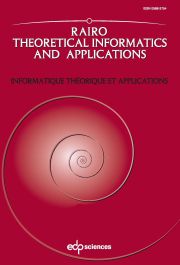Article contents
Infinite words containing squares at every position
Published online by Cambridge University Press: 11 February 2010
Abstract
Richomme asked the following question: what is the infimum of the real numbers α > 2 such that there exists an infinite word that avoids α-powers but contains arbitrarily large squares beginning at every position? We resolve this question in the case of a binary alphabet by showing that the answer is α = 7/3.
- Type
- Research Article
- Information
- RAIRO - Theoretical Informatics and Applications , Volume 44 , Issue 1: Special issue dedicated to the 12th "Journées Montoises d'Informatique Théorique" , January 2010 , pp. 113 - 124
- Copyright
- © EDP Sciences, 2010
References
- 4
- Cited by


